CHILDREN'S COSTUMES at SCA EVENTS
a personal testimonial
Ælflæd of Duckford, 1987with follow-up photos from later years
I've been known to go pretty far to prove a point, and so I had a baby of my own. He's over a year old, and he's always been in costume at events. He has crawled, and he has walked. I made three costumes, received others as gifts or hand-me-downs, and a couple of items were makeshift from mundane parts—in combination with other things, he's worn tights, knitted leggings (heavy tights without feet), a Danish hooded drawstring gown, and a Mexican shirt. I made him breeches with feet and a coif from the pattern of their modern equivalents—bonnet and pajama bottoms (McCall's #9331). Once when he needed to appear in diaper only, I covered up the plastic diaper with a large gauze rectangle, tied in knots at the sides, and it looked just like a cloth diaper, but still had the practical advantages of Ultra Pampers. (I've never been against modern underwear personally, but if you prefer and can create period-to-the-skin costumes, that's great).
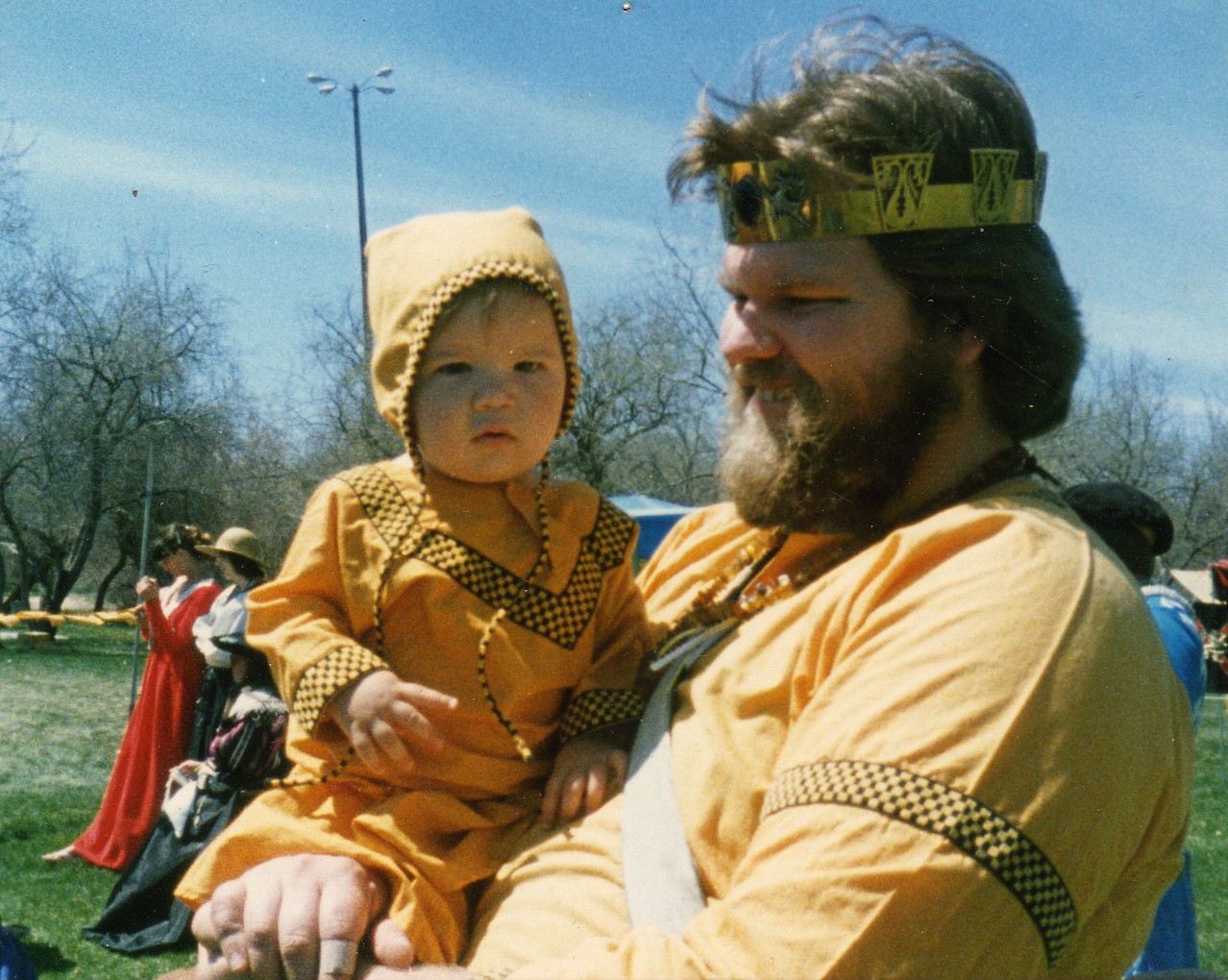 Magnus and Gunwaldt |
These bands, which varied very little through history, and which turned the child into a tight cocoon, unable to move in any direction, were used with a tenacity which resisted generations of reformers. They had the considerable convenience of allowing the mother or nurse to carry the little parcel around with some degree of safety. . . . There was also a grossly mistaken but probably often honest belief that tight binding would not only protect the child from falls and other accidents but would also encourage the straightness of legs and arms, which were at all times encompassed in the bands. That the child might suffer perilously from lack of freedom and exercise and even die in the convulsions of frustrations, pain or fury seems not to have even been considered.The book goes on about "swatheling" (the period word was spelled with a ð which had a "th" sound) for a couple of pages. It's a 1977 Charles Scribner's publication. I got it at the Albuquerque Public Library.
The Tudor clothing of small boys seems to have been identical to little girls' clothes, at least in formal portraits. "Family portraits galore show such boys in the same full-length bell-shaped skirts as their sisters and mothers," says Ewing, but she says sometimes the bodices weren't identical but had "a hint of manliness in doublet-style designs borrowed from their fathers." Anyway, I don't think it would go over great now to dress any little four-year-old boys like Queen Elizabeth. At the age of six or so, a ceremony was made of dressing the boy in his first breeches, and sending him off to school. If this paragraphs interests you, definitely find History of Children's Costume—it has more.
A Pudding — This is a padded roll put around the baby's head as a crash helmet. Falls on stone floors or bumps into iron-clad trunks would go easier! A 1620 (?) Rubens engraving shows a child with a pudding and reins.
Muckinder — "—a large man-sized handkerchief usually attached to the waist of the dress by one corner and hanging down to the floor-length hem," says Ewing. She says it must have had many uses. If you can't think of any, ask a mom. The root word is "muck." Now if you want to hang a drool rag off your kid, you have a great old name to call it. The preferred spelling in the Oxford English Dictionary is "muckender," and their first reference is 1425. Early on the word meant a bib, and later was used more generally as a napkin.
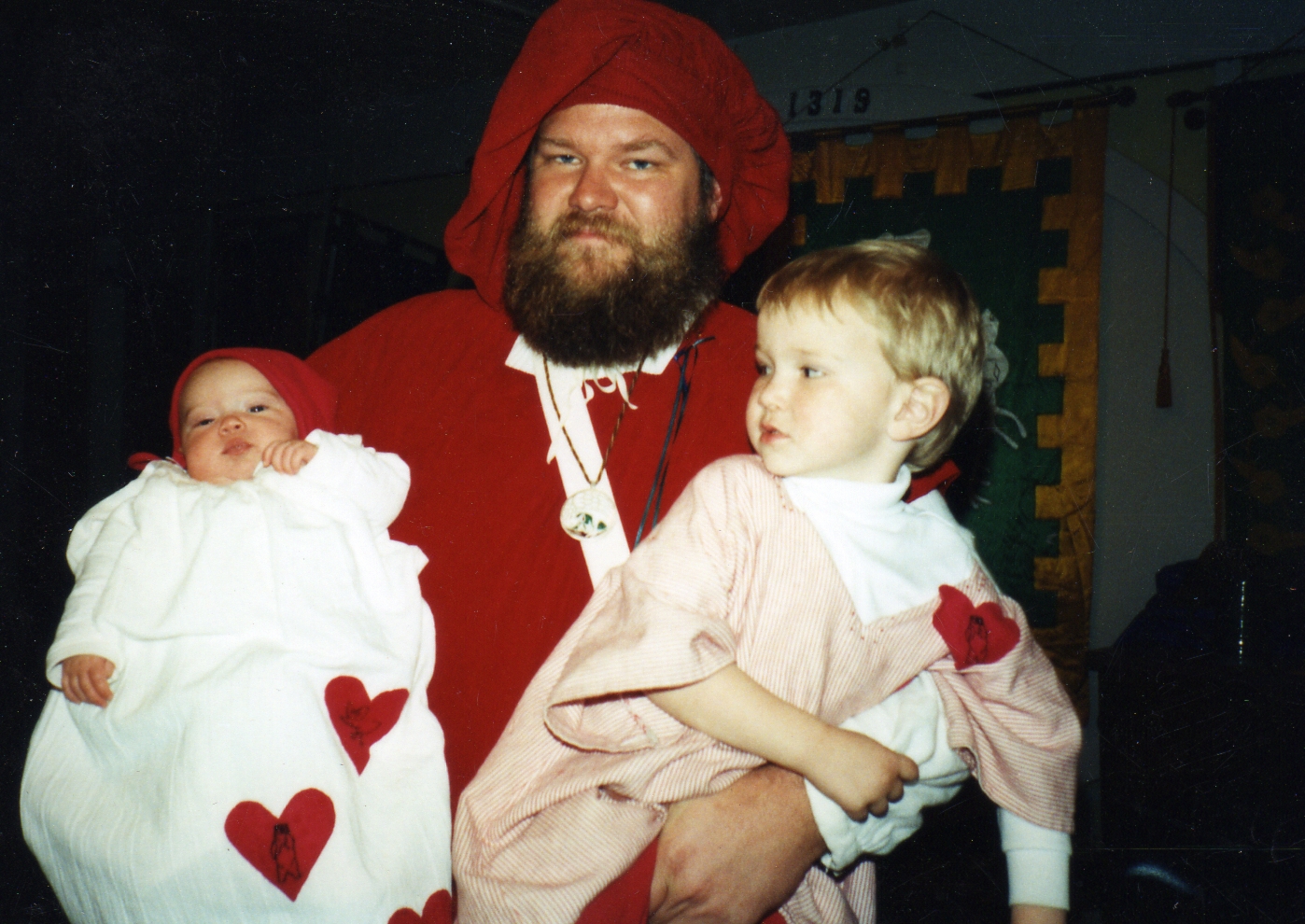 Love Revel in al-Barran; Asta, Gunwaldt, Jeffery Paul (later "Bardolf") |
 Bardolf at the SCA's Argent Anniversary |
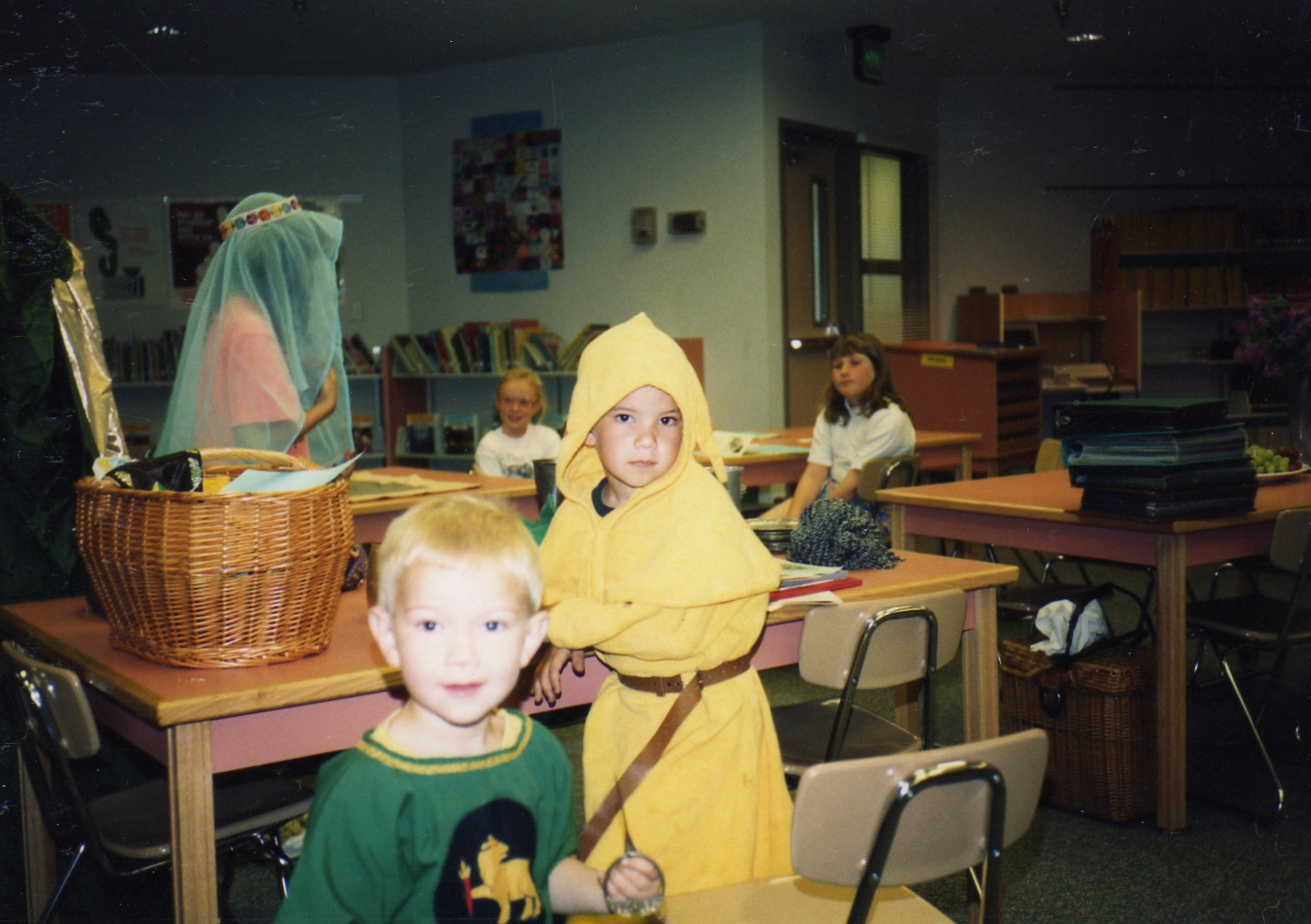 Bardolf and Magnus at a demo in Edgewood |
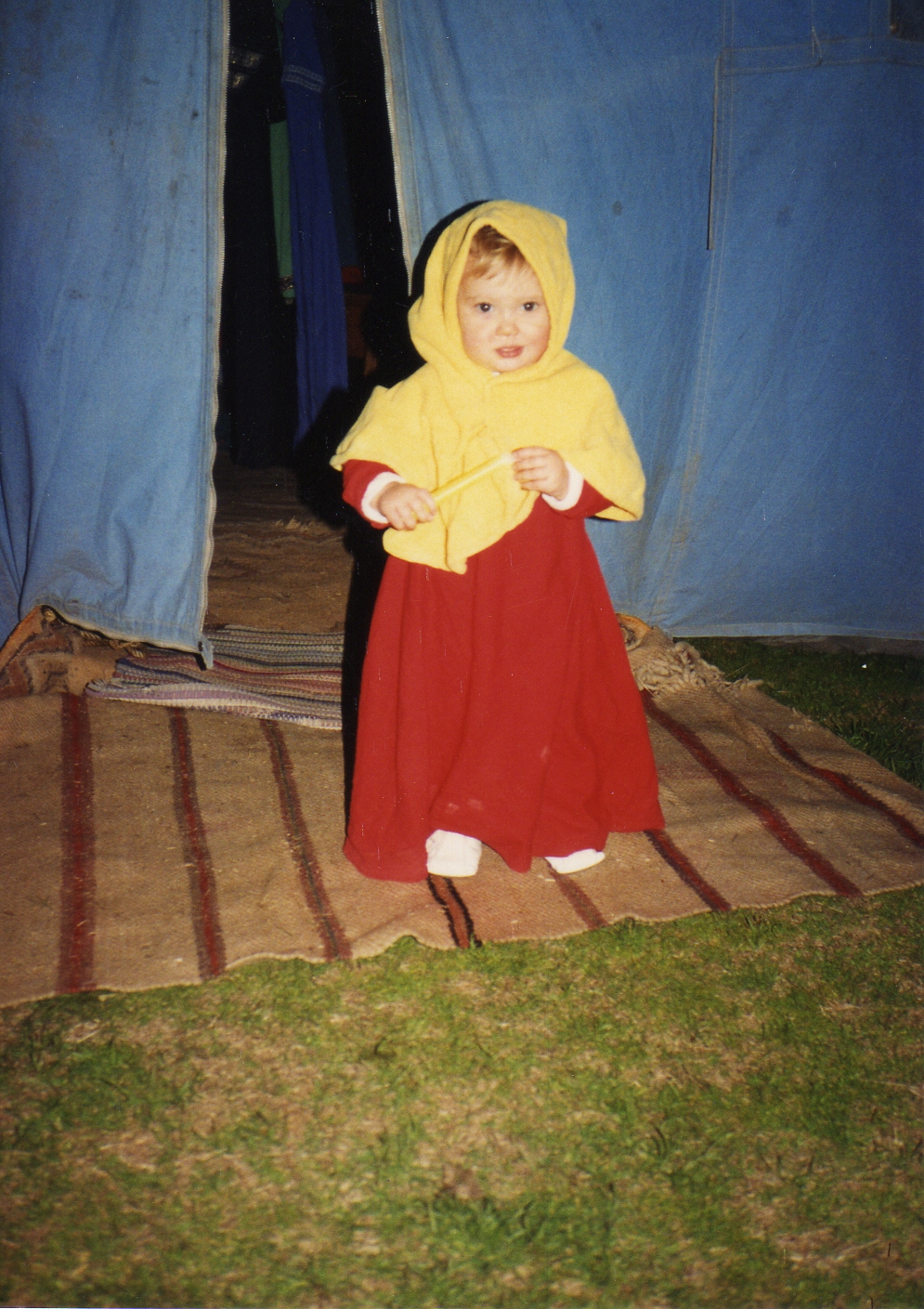 Asta at Estrella, in her brother's yellow hood, her own red dress, and white leather baby booties (commercial). |
The article above originally appeared in an Arts and Sciences special issue of The Outlandish Herald, November A.S.XXII (1987).
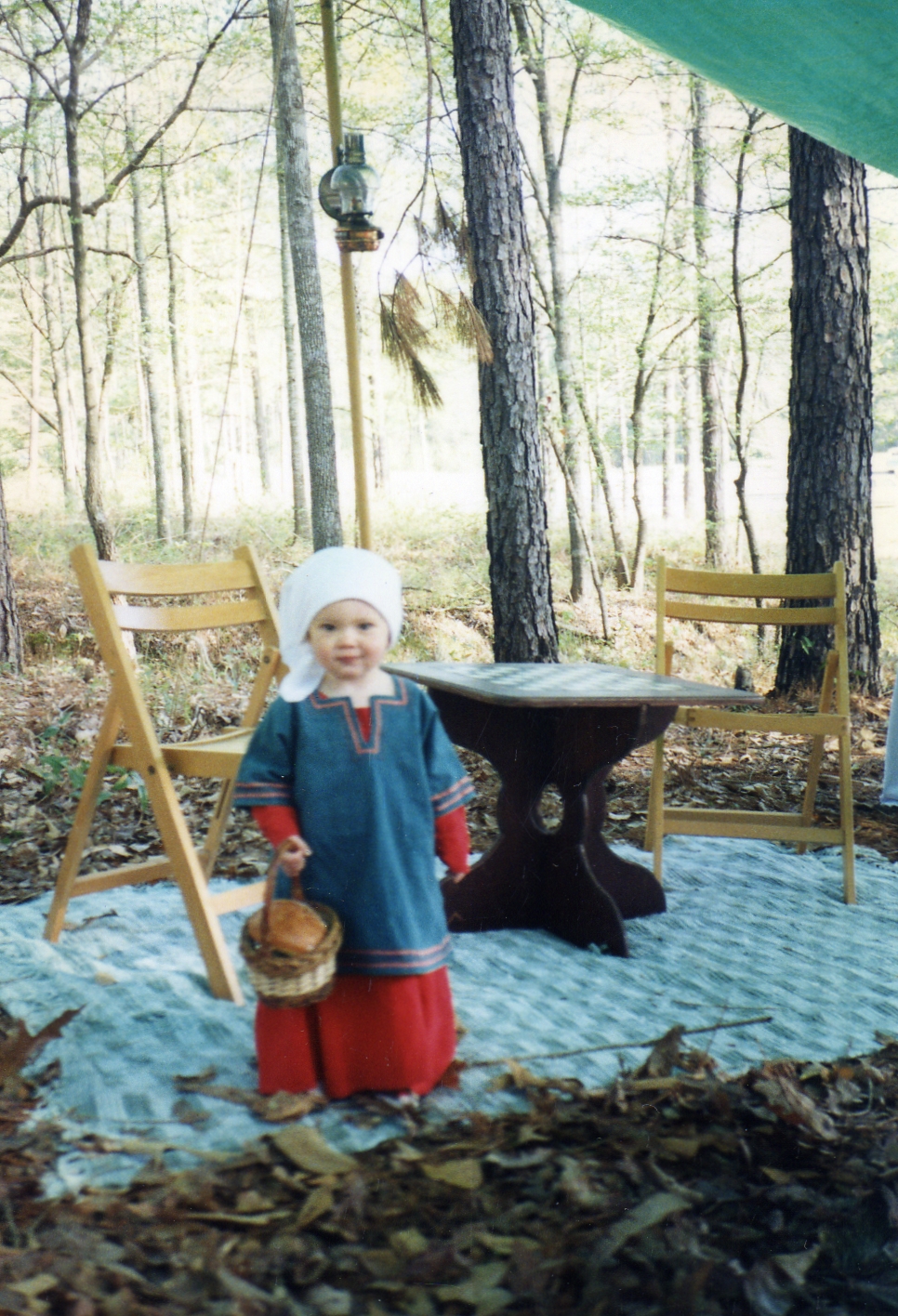 Asta at Fool's War in Meridies, with her lunch in a basket and her paperwork under the lunch |
I recently read your article on making baby and children's garb. I agree with you that children should be in garb at events. I did make a few things for each of my girls, and had great success with two ideas that I had for evening and morning.I made a large tabbard for evening when my youngest daughter was just born. I put her in her footed pajamas, covered her legs with a blanket and put the (my bad here) fleece tabbard over the top to keep her warm and her modern clothing hidden. She was very comfortable.
I also did the same thing for my older daughter with a long nightgown. She wore a thermal one piece underwear as pajamas, and I made a long flannel cross dress to cover it. She would not have been warm enough in garb alone, but loved her SCA jammies!
Also, making a children's circle cloak is too easy! And I see so many jackets at events.
Karen Jones wrote:
I wanted to make a suggestion for period garb for babies. I don't do SCA, but I participate in the local ren fest.If you can find a white cotton shift or dress, that works well for a baby that can't crawl yet. find one that's actually too big for your baby so that the skirt is quite long. The one I used was sleeveless for the end of summer and then I put a long-sleeved cotton shirt under it when it got cooler. You couldn't tell unless you looked close. Also, when it was cool, I tied a red wool scarf around her head as a hood. Just a regular adult scarf. It looked amazing. Underneath, in either case, I had her wear regular white tights. It was close enough and I didn't have to sew a thing.
Another suggestion. If you can find a christening gown on ebay that isn't too frilly, that works too.
As of 2021, these links are working, mostly with archived copies at The Wayback Machine at the internet archive (a repository of great value).
Photos of a girl's garb with info on "reverse facings" (finishing the edge with trim on the outside, so that the inside of the garment is very clean and the edges are lined—you'll see from the photos). The author/mom is Ciorstan.
Kids' Garb, Briaca. Photos and specific recommendations, and you can follow links from there to period art showing children's clothing.
An Infant's Clothing — Swaddle, Gown, Shirt, and Coif by Charlotte Johnson (Lady Mathilde Bourette), with many photos and period illuminations
| Use a computer. It's over 20 pages on a computer, and on my phone, just shows one photo and a caption; sorry; beyond my control. |
T-Tunic diagram and notes; remember to test the neck hole to make sure it will go over the baby's big head comfortably!
What Kids Wore 1477-1577, by Sarah Lorraine Goodman, with period art to illustrate, and practical recommendations concerning children.
This doesn't really tell how to change the diaper, but how often (seven hours) and how the nurse should sit and clean the baby.
How to Change a diaper in 1612